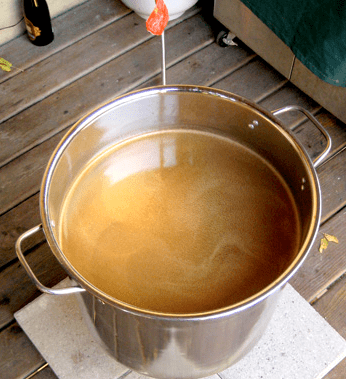 Hi everyone! I’m sitting here smelling the sweet smells of fermentation right now, and just pondering how it’s going to all turn out! In case you forgot or did not read my previous entries, I am attempting to make my first mead at home after trying grape kits for a little while.
Hi everyone! I’m sitting here smelling the sweet smells of fermentation right now, and just pondering how it’s going to all turn out! In case you forgot or did not read my previous entries, I am attempting to make my first mead at home after trying grape kits for a little while.
Fermentation seemed to get off to a great start—it was doing it’s thing by 24 hours after adding the yeast, which is exactly what I expected based upon the mead recipe I had. I’m a little nervous; however, as the smell of this particular fermentation is not as “nice” as the smells of the other fermentations I’ve done in the past. Of course, I’m using a completely different product (honey as opposed to grape juice), so I would expect the mead fermentation to smell a little different, however, since I’ve never made mead before, nor have I ever smelled honey fermentation, I’m not sure if what I’m smelling is normal or if what I’m smelling means bad news bears.
Now, it basically smells like fermentation, but with a little bitter-like tinge to it. I don’t know if bitter is quite the proper word to describe it, but it definitely smells a lot different than when I fermented with grape juice. I’m probably just being paranoid and the mead is fermenting along its merry way just as it is supposed to, but I’m just a teeny bit nervous anyway! It kind of reminds me of the smell my fiancé’s “wine” made when he just threw a bunch of things together without following any kind of instructions. I’m hoping my honey wine will continue to develop along a more palatable path than my fiancé’s wine did.
The mead recipe told me to go ahead and siphon the mead into a carboy after 5 to 7 days, and I’ve decided to “play it safe” and just wait the whole 7 days. So, I’m a little over half-way there now, and keeping my fingers crossed that all is well with this batch!
One thing I will need to look into prior to the very end of this project is to figure out how to properly sweeten a dry wine. I know there are instructions for this on ECKraus, so I will definitely be giving that section of the site a little visit to figure out what I need to do in order to sweeten my mead, and what ingredients I might have to purchase in order to be successful in doing this. I’m keen to sweeten this batch of mead, as I’m not sure I’ve ever had a dry mead! If the dry mead taste heavenly, then I might just leave it dry, but I definitely want to be prepared in the event I need to give it a little extra of the liquid gold at the end!
————————————————————————————————————-
 My name is Leigh Erwin, and I am a brand-spankin’ new home winemaker! E. C. Kraus has asked me to share with you my journey from a first-time dabbler to an accomplished home winemaker. From time to time I’ll be checking in with this blog and reporting my experience with you: the good, bad — and the ugly.
My name is Leigh Erwin, and I am a brand-spankin’ new home winemaker! E. C. Kraus has asked me to share with you my journey from a first-time dabbler to an accomplished home winemaker. From time to time I’ll be checking in with this blog and reporting my experience with you: the good, bad — and the ugly.

New to Mead myself. We both are probably using the same instructions. I have had the same result as you but my concern is the color. Seems to be very cloudy. I’ve racked once and since this is an apple mead it’ll going to be racked a few times and age at least a year.
For Leigh,
Expect your mead to be dry when you are through the fermentation and racking process. Also, mead is one of those wines that really benefits from a little aging. Well, that’s been my experience 😀
Thank you John and Robin. I don’t know for sure but I would imagine I will want my mead dry as well. I will try to be patient and let it age.
Very cool that you’re diving into meads. Just a note, we don’t even think about judging a mead before 6 mo. Gotta age it.